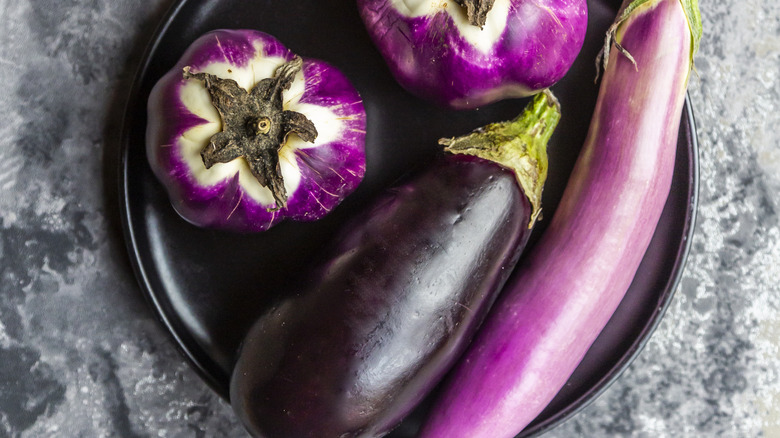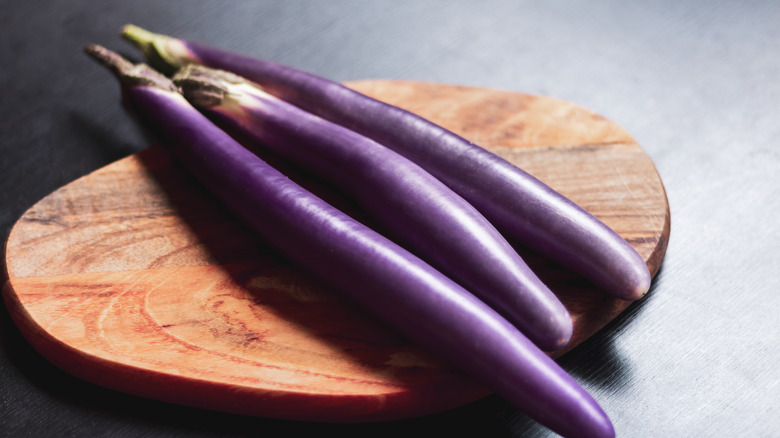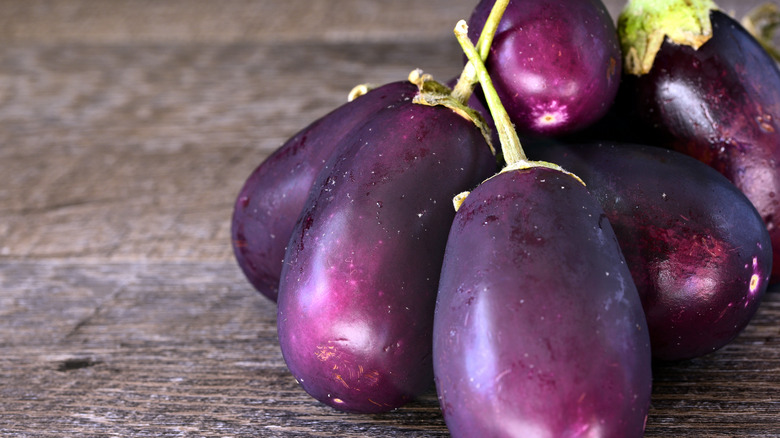What's The Difference Between Japanese And Italian Eggplant?
When you think of eggplant, one variety likely comes to mind. For Americans, it's the round, squat variety fittingly called the American eggplant (also known as the globe eggplant), but that's not the only type. In fact, there is a wide world of eggplant varieties including the grape-like Indian eggplants, striped Sicilian eggplants, green-hued Thai eggplants, tiny fairy tale eggplant, as well as green and white eggplants, but two especially notable ones for their cooking versatility are Italian and Japanese eggplants.
While these two eggplants are both usually purple with similar green stems and tough skin, there are some obvious differences in appearance. Japanese eggplants are typically long and thin like cucumbers while Italian eggplants are stout and round (just like globe eggplants), looking almost like compressed versions of their Japanese counterparts. The differences extend beyond just appearances, however, as both their flavors and textures also set them apart.
What is Japanese eggplant?
Japanese eggplant, called "nasu" in Japan, is a long, slender fruit typically seen with purple skin. However, there are some variations in its color, including green, which was the plant's original color when it was a small round fruit before being selectively bred into its modern shape to remove its prickles. Even its shades of purple vary from a bright magenta to a deep black-purple hue. Different types of Japanese eggplants have different colors, like shoya long (purple), kurume (purple-black), and choryoku (green). While called Japanese eggplant, it can be found throughout Asia and is frequented in all manner of Asian dishes like hoisin eggplant with tofu as well as eggplant and mushroom stir fry.
It has a sweeter flavor than Italian eggplant, lacking eggplant's typical bitterness and featuring a silky smooth texture. When looking for quality Japanese eggplants, seek out ones that have shiny skin without any brown spots. Because they're thinner, these eggplants cook and absorb flavors faster than round varieties, so keep an eye on them during cooking. The best options for cooking Japanese eggplant include dry-heat methods like grilling and pan-frying. If you can't find this eggplant type, Chinese eggplant is a good substitute in a pinch, which is similarly long, thin, and sweet. Japanese eggplants have a myriad of culinary uses, but for those who prefer working with eggplants closer to the globe variety, Italian eggplant is your best bet.
What is Italian eggplant?
Italian eggplants, also known as baby eggplants, are similar in appearance to globe eggplants, but with subtle differences. Despite the name, these eggplants actually originated in China and India, not Italy. They were brought to Italy via Arabian trade routes and have since become a frequent inclusion in Italian dishes like eggplant caponata or combined with other Mediterranean ingredients such as feta and cucumber in grilled eggplant dishes.
This variety has a stronger flavor than Japanese eggplant as well as softer flesh. Because it is more bitter than eggplant types like Japanese, it's best to buy Italian eggplant fresh since it becomes more bitter over time. Just like with Japanese eggplant, there are different varieties of Italian eggplant, which tend to be more colorful (such as containing stripes) but cook similarly. These types include traviata, naida, rosa bianca, and nubia. Italian eggplants are great for baking, frying, grilling, and sautéing, not unlike globe eggplant. Just like how Japanese eggplant is great in Japanese dishes, Italian eggplant is great for Italian dishes, shining with cheese and herb pairings. While both have significant differences and just scratch the surface when it comes to eggplant varieties, Japanese and Italian eggplants deserve a spot in your kitchen for their versatility and flavors.


